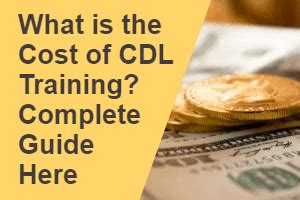The Ultimate CDL Training Guide: Time & Costs
The path to becoming a professional truck driver, a career offering independence, competitive pay, and the satisfaction of keeping the country moving, begins with Commercial Driver's License (CDL) training. However, understanding the time commitment and financial investment required is crucial before embarking on this journey. This guide will break down the typical timeframe and costs associated with CDL training, helping you make an informed decision.
How Long Does CDL Training Take?
The duration of CDL training varies depending on several factors, including:
- Program Type: Accelerated programs may condense training into a few weeks, while more comprehensive programs extend over several months. Some programs offer specialized training for certain types of vehicles (e.g., hazmat, passenger endorsements).
- Prior Driving Experience: Individuals with previous driving experience might complete training faster than those with none. Many programs offer placement testing to assess existing skills and adjust the curriculum accordingly.
- Learning Style: Some students grasp concepts more quickly than others. Individual learning paces affect overall training time.
- Program Intensity: Full-time programs typically conclude quicker than part-time options.
Typical Timeframes: Expect to spend anywhere from 4 to 8 weeks in a full-time CDL training program. Part-time programs can stretch the training over several months.
What are the Costs Associated with CDL Training?
CDL training expenses are significant and vary based on several factors:
- School Location: Training costs differ greatly depending on the geographical location of the school. Urban areas typically have higher costs than rural locations.
- Program Type: Comprehensive programs including extra endorsements (like hazmat or passenger) or advanced training will usually cost more.
- Included Services: Some schools include the cost of the CDL test in their tuition, while others charge an additional fee. The cost of materials, such as textbooks or uniforms, may also vary.
- Financing Options: Many schools offer financing options, which can impact the overall cost depending on interest rates and repayment terms.
Typical Cost Ranges: The total cost for CDL training can range from $4,000 to $8,000 or more. This encompasses tuition, fees, materials, and potentially the cost of the CDL exam. Remember to factor in additional expenses such as transportation, accommodation (if you're relocating for training), and living expenses during the training period.
What are the Financing Options Available?
Securing financing for CDL training is often necessary. Several options exist:
- School Financing: Many driving schools offer in-house financing plans. These plans often have specific terms and conditions you should carefully review.
- Federal Student Loans: Depending on your eligibility, federal student loans can potentially help fund CDL training.
- Private Loans: Several private lenders offer loans specifically for vocational training, including CDL programs.
- Grants and Scholarships: Some organizations offer grants or scholarships to individuals pursuing CDL training. Researching these opportunities can significantly reduce your financial burden.
Always compare financing options carefully to determine the best fit for your budget and financial situation. Understand interest rates, repayment terms, and any associated fees before committing to a loan.
How Can I Reduce the Cost of CDL Training?
Several strategies can help reduce the overall cost of your CDL training:
- Research and Compare: Thoroughly research different CDL training schools and compare their tuition, fees, and included services.
- Look for Grants and Scholarships: Explore potential grants and scholarships that can offset training costs.
- Take Advantage of Veterans' Benefits: If you're a veteran, explore veterans' benefits that may cover or partially cover your CDL training expenses.
- Negotiate Tuition: Inquire about any potential discounts or tuition negotiation options available at the school.
- Consider Part-Time Programs: Although it extends the training period, part-time programs might be more manageable financially.
What are the hidden costs I should consider?
Beyond the tuition, there are other expenses you need to account for:
- Physical Exam: You will need a Department of Transportation (DOT) physical exam before you can obtain your CDL.
- Background Checks: Many schools require background checks as part of the enrollment process.
- CDL Test Fees: If your tuition doesn't include these, remember to factor in the fees associated with taking the CDL exam itself.
- Materials and Uniforms: Some schools supply uniforms and materials but others may not. Budget accordingly.
- Transportation and Accommodation: If your training location isn't nearby, factor in costs for travel and housing.
By carefully planning and considering all aspects of time and cost involved in CDL training, you can pave the way for a successful and rewarding career as a professional truck driver. Remember thorough research and planning are crucial to making this substantial investment worthwhile.

